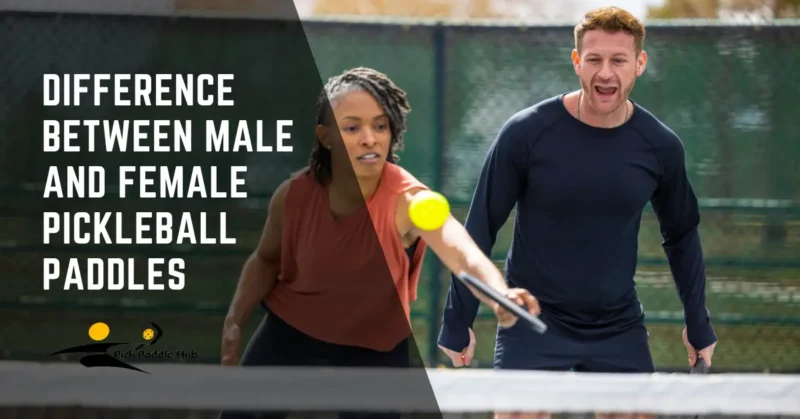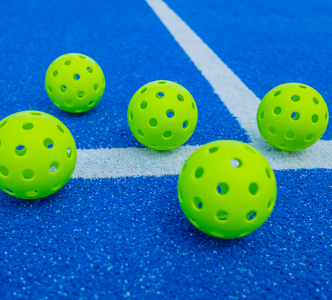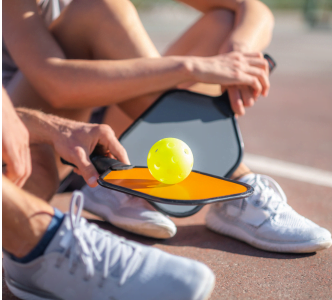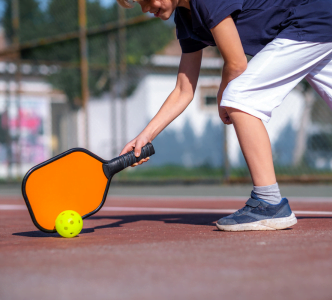Ever wondered why some pickleball paddles just feel better in your hands than others? It might not just be about personal preference; it could also be about the subtle difference between male and female pickleball paddles. Imagine stepping onto the court with a paddle that feels like it was made just for you. In this guide, we’ll dive into the nuances that distinguish men’s and women’s paddles, making your choice clearer and your game stronger.
Major Difference Between Male and Female Pickleball Paddles
Generally, pickleball paddles have no inherent design differences based on gender. Manufacturers usually do not create “male” or “female” specific paddles. Instead, paddles are designed to cater to various play styles, skill levels, and personal preferences, which can be gender-neutral.
You might also want to read about the Difference between pickleball paddles.
Physical Differences Affecting Paddle Choice

While there are average physical differences between men and women, such as hand size, height or strength, these differences don’t necessarily require different paddle designs. Instead, players should focus on finding a paddle that feels comfortable and enhances their playing style, regardless of gender.
How Does Grip Size Impact Play for Men and Women?
For men, who generally have larger hands, a larger grip size can provide better control and reduce the risk of the paddle twisting during play. A grip that fits well in the hand allows for more precise shots and can help in applying more power without extra strain. However, if the grip is too large, it can make the paddle cumbersome to handle, potentially leading to a decrease in maneuverability and quickness of wrist movements.
Women, on the other hand, tend to have smaller hands, and therefore, a smaller grip size is often more suitable. A smaller grip allows for easier handling and quicker wrist action, which can be particularly beneficial for executing soft shots, and dinks, and serves with finesse. A grip that’s too large for a woman’s hand can cause difficulty in gripping the paddle securely, leading to a loss of control over the paddle’s angle and direction of the ball.
Weight Distribution
The weight distribution in a paddle can affect power and control. Heavier paddles can provide more power, while lighter paddles offer better control and quickness. This choice is based on personal play style and strength, not necessarily on gender.
Design Preferences
While design preferences can vary among individuals, these variations are more related to personal taste rather than gender. Some players might prefer brightly coloured or patterned paddles, but this is a matter of personal preference.
How Do Core Materials Affect Male and Female Players Differently?
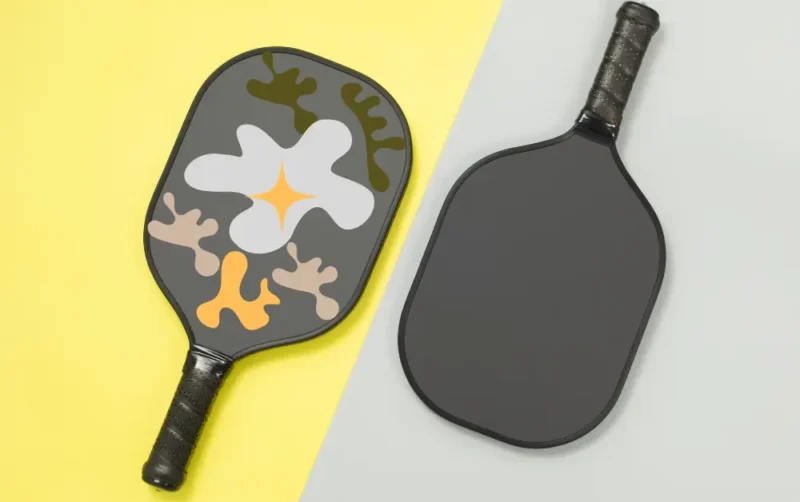
The core material of a pickleball paddle plays a pivotal role in its performance characteristics, such as control, power, and feel. While the impact of core materials on male and female players isn’t inherently gender-specific, differences in playing style, strength, and preference can lead to varied experiences between men and women.
Polymer Cores
Known for their soft feel and control, polymer cores are popular among players who value precision over power. Women, who might focus on strategy and placement, may find polymer cores advantageous for their game, allowing for nuanced shots and better ball control. However, men who prefer a power-driven style can also benefit from the shock-absorbing qualities of polymer, reducing fatigue during aggressive play.
Nomex Cores
Nomex is harder and produces a louder pop, catering to players seeking speed and power in their shots. Men might gravitate towards Nomex cores to maximize their strength advantage, achieving faster serves and returns. Women, particularly those with a powerful playing style, can also leverage Nomex cores to enhance their game, though the reduced control might be a trade-off for players focusing on finesse.
Aluminum Cores
Offering a balance between power and control, aluminum cores can suit players who enjoy a strategic game. This core type might appeal to women looking for a paddle that supports a varied playing style, allowing for both powerful smashes and controlled shots. Men who value precision alongside power might also prefer aluminum cores for their versatility.
Why Consider Gender Differences in Paddle Design?
Firstly, the difference in physical strength between genders can affect the ideal weight and balance of a paddle. A paddle that’s too heavy might hinder a player’s speed and agility, while one that’s too light may not provide enough power behind shots. Men might prefer heavier paddles that capitalize on their natural strength, allowing for powerful serves and returns. Women, on the other hand, might opt for lighter paddles that offer quicker maneuverability and ease of handling, aligning with a playing style that leverages finesse over brute force.
Secondly, hand size plays a crucial role in selecting the right grip size. A grip that’s too large can make the paddle difficult to handle and increase the risk of tennis elbow, while a grip that’s too small can lead to unnecessary wrist strain. Women’s hands tend to be smaller than men’s, necessitating a smaller grip size for optimal comfort and control.
Lastly, the playing style, which can vary widely among individuals, often shows trends among genders. Women may prefer a strategic game that focuses on placement and control, requiring a paddle that enhances touch and precision. Men might lean towards a power-driven approach, benefiting from a paddle that supports forceful shots.
Do Men and Women Benefit from Different Paddle Dimensions?
Yes, men and women can benefit from different paddle dimensions due to variations in physical attributes, playing styles, and personal preferences. Paddle dimensions, including length, width, and the size of the sweet spot, play a significant role in how a paddle performs and feels during play. Tailoring these aspects to fit the needs of male and female players can enhance their game experience and performance.
Length and Reach
Men, often having longer arms and taller statures, may prefer paddles with longer lengths. These paddles offer an extended reach, allowing players to cover more of the court and hit balls that might otherwise be out of reach. Women, on the other hand, might find a slightly shorter paddle more manageable and easier to maneuver, especially for quick volleys and shots close to the net.
Width and Sweet Spot
A wider paddle can provide a larger sweet spot, which is the area on the paddle that provides the most effective and controlled hit. Women, particularly those who are refining their skills or prefer a game based on precision and strategy, might benefit from a paddle with a wider face. This can make it easier to hit the ball consistently well. Men, who might focus on power and speed, could prefer a paddle with a narrower face that offers more concentrated power, assuming they are comfortable with a smaller sweet spot.
Weight Distribution
The balance and weight distribution of a paddle can also affect play. A paddle that is heavier towards the head can provide more power, which might be preferred by men aiming to maximize their serve speed and return force. Women might prefer a paddle with a more balanced weight distribution or one that is slightly lighter, allowing for quicker reactions and more finesse in their shots.
How Important Are Color and Design in Choosing a Pickleball Paddle?
While colour and design might not directly impact the performance of a pickleball paddle, they play a significant role in a player’s choice due to personal preference and psychological factors. A paddle that appeals to a player’s aesthetic taste can boost confidence and enjoyment on the court, making the game more enjoyable.
For some, a brightly coloured or uniquely designed paddle can serve as a form of personal expression, or even a psychological advantage, by standing out from the competition. Additionally, teams or clubs might choose paddles with specific colours or designs to create a unified look. Ultimately, while the technical specifications of a paddle, such as its material, weight, and grip size are paramount in ensuring optimal performance, the colour and design can enhance the playing experience by reflecting the player’s personality and style.
What Do Top Male and Female Players Say About Paddle Choice?
Top male and female pickleball players often emphasize that paddle choice is a highly personal decision, influenced by an individual’s playing style, physical attributes, and comfort preferences.
They highlight the importance of selecting a paddle that complements one’s strengths and mitigates weaknesses. For instance, players who prioritize power in their game might opt for heavier paddles with a stiffer core material, allowing them to drive the ball with more force.
Conversely, those who value control and finesse might choose lighter paddles with a softer core, offering better touch and maneuverability.
Many professional players stress the significance of grip size and shape, noting that a proper fit can drastically improve paddle handling and reduce the risk of injury.
They also point out that the paddle’s surface material can affect ball spin and speed, suggesting that players experiment with different surfaces to find what best suits their technique.
Conclusion
The choice of a pickleball paddle should be based on individual factors like hand size, strength, play style, and personal preferences in weight and design, rather than on gender stereotypes. Players of any gender can use any paddle that suits their needs and enhances their game.
FAQs
Is there a difference between pickleball paddles designed for men and women?
No, pickleball paddles are generally designed to be gender-neutral. The choice of paddle should be based on individual factors like hand size, strength, and playing style, rather than gender.
How should I choose a pickleball paddle that suits my hand size?
Look for a paddle with a grip size that feels comfortable in your hand. A proper grip size enhances control and reduces the risk of injury. If you have smaller hands, you may prefer a smaller grip circumference, and vice versa.
Does the weight of a pickleball paddle affect performance differently for men and women?
The weight of a paddle affects performance based on personal strength and playing style, not gender. A heavier paddle can provide more power, while a lighter paddle offers quicker movement and better control.
Are there specific design features in pickleball paddles that cater to women?
Design features in pickleball paddles, such as colour or pattern, are a matter of personal preference and do not cater specifically to any gender. Players should choose a design that appeals to them personally.
Can men and women use the same pickleball paddle for competitive play?
Yes, men and women can use the same pickleball paddles for competitive play. The most important factors are the paddle’s compliance with official regulations and suitability for the player’s skill level and style, regardless of gender.

